Time:2025.04.10Browse:1

Thermal printers designed for express waybills play a crucial role in the logistics industry. They streamline the process of generating shipping labels and waybills, enhancing the overall efficiency of courier services.
The operation of these printers is based on a straightforward yet highly effective principle. As introduced, thermal printers use a thermal printhead, which contains heating elements. When an electrical current passes through these elements, they heat up. The heat then reacts with the special coating on the thermal paper, causing it to change color and form text or graphics. This method enables quick and quiet printing, making it ideal for busy courier offices and distribution centers.
In the logistics context, these printers are required to handle a high volume of printing tasks. They need to be able to print various types of information, including barcodes, tracking numbers, sender and recipient addresses, and package details. Many thermal printers for express waybills support different paper sizes and formats, ensuring compatibility with the diverse requirements of different courier companies. For example, some printers can print on both standard A4 - sized waybills and smaller label - sized papers, providing flexibility in label creation.
Connectivity is another important aspect. Modern thermal printers for express waybills often come with multiple connectivity options, such as USB, Ethernet, and Wi - Fi. This allows them to be easily integrated into existing logistics systems. For instance, they can be connected to a computer network, enabling seamless printing of waybills directly from courier management software. Some advanced printers even support mobile printing, allowing couriers to print waybills on - the - go using their smartphones or tablets.
Durability is a key feature of thermal printers for express waybills. Given the demanding nature of the logistics industry, these printers need to withstand continuous use, vibrations during transportation, and various environmental conditions. They are typically built with robust materials and designed to minimize maintenance requirements. Additionally, they often have a high - speed printing capability, which can significantly reduce the time spent on label printing, especially during peak shipping seasons.
The development of software for these printers has also made the printing process more efficient. Some software allows for batch printing, where multiple waybills can be printed at once. This is particularly useful for large - scale courier operations. Other software features include automatic data filling, which can populate waybill templates with relevant information, reducing the risk of human error.
Read recommendations: